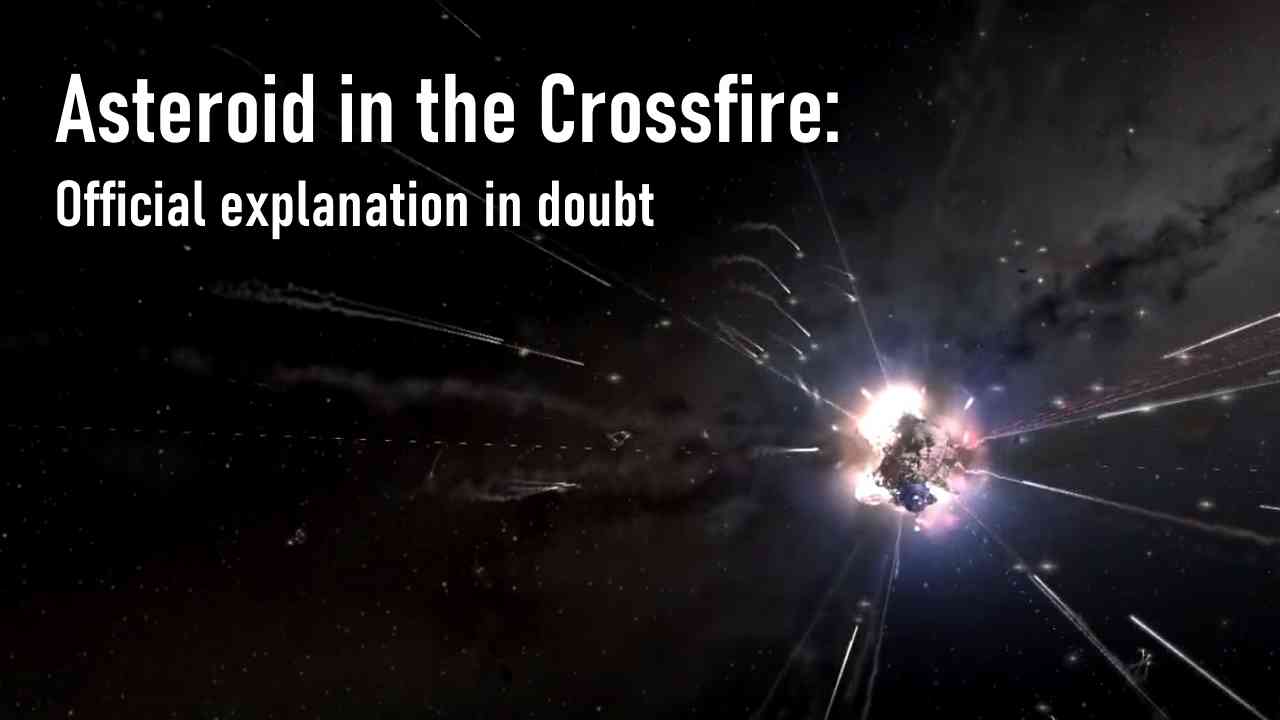
2540 Asteroid Under Attack

Military forces of the inner system bombard a vulcanoid asteroid and then steer the body into the Sun. Officially a test. Many observers suspect an out-of-control experiment with outlawed technology.
Mukhagni is a small asteroid inside Mercury's orbit. Sensors reveal several 100 megaton antimatter explosions at its supposed position in short order. The event causes a system-wide outrage. Two days later, combat units of the Magadha Sangha Federation, Venus begin firing at Mukhagni from great distance. Military units approach Mukhagni on expensive max delta-V courses from all directions under sustained firing.
The news agencies of the Sol System broadcast live. State of the art telescopes achieve a resolution of 20 meters even over interplanetary distances. They clearly show the effects of the bombardment. But the telescopes fail to reveal the reason for these excessive military measures.
A few days later freighters from Venus and Mercury transport additional ordnance to Mukhagni. Commercial mass drivers in Mercury's orbit support the bombardment. Soon it becomes clear that the mass drivers work to reduce the asteroid's kinetic energy and angular momentum in order to change its orbit towards the Sun.
After several weeks Mukhagni's orbit becomes elliptical, and the asteroid approaches the Sun. Attacks stop at a distance of ten million kilometers. The kinetic component of the bombardment by mass drivers continues until the orbit finally falls below the Roche limit where the asteroid breaks apart. The remaining fragments of the asteroid fall into the Sun.
The official explanation is a combat exercise, which was supposed to neutralize a kinetic threat, the asteroid, with simultaneous suppressive fire. A test by the Magadha Sangha Federation to protect the population of the inner system in response to the Umvelinqangi incident a few years earlier. However, this does not explain the initial antimatter detonations.
Actually, Mukhagni was a research facility of Ratha-Musala (the development office) of Ayatashatru (the interplanetary intelligence service) of the Magadha-Sangha (a federation of wealthy Venus habitats). Contrary to the official statement, a secret research project on the asteroid had got out of control. The initial amat-detonations were intended to sterilize the asteroid and eliminate the problem. But this did not yield the expected result. Obviously, the people responsible for the operation saw no other possibility than to plunge the asteroid into the Sun.
Of course, the public suspects illegal AI research as happened during the Newplace conspiracy a 100 years earlier. At that time, the asymptotic development of a gestalt-AI had to be suppressed by a spherical wave of antimatter explosions. In the case of Mukhagni, Ratha-Musala had obviously taken precautions and had installed heavy explosive devices as an emergency measure. This was a lesson from the Newplace experience. Ratha-Musala also had the wisdom to detonate the explosives. But that apparently was not enough. Whatever there was at Mukhagni, it was so powerful that it could withstand even concentrated attacks from several heavy cruisers, their missiles and attack drones.
What can be more dangerous than the Newplace AI? There are hints at superior technology. Did an asymptotic AI develop new technologies in a very short time? Or did Ratha-Musala have access to extrasolar technology so early?
According to another theory, Ratha-Musala experimented with Kessler-Viroidae, discovered by Zipi Kessler in 2478. Supposedly, without intending it they activated the disassembler genes of these inorganic viruses (see Massara plague, 2746). If this were true, then the purpose of the nuclear bombardment would have been to sterilize the fragments ejected by kinetic impacts. Correlations between kinetic and nuclear firing sequences support this theory.
The fact that solar powers conduct secret and sometimes forbidden research projects with outlawed technologies is not surprising. They often use small remote asteroids for this purpose. Asteroids provide more cover from the ubiquitous telescopes than space stations. Over the centuries, several such activities have been uncovered, mostly by chance, misfortune, or by the lack of care on the part of the operators. A restricted area without military activities is a clear sign of some secret project going on, though not necessarily an illegal one.
Ratha-Musala had chosen a vulcanoid close to the Sun for their research facility on purpose. As a precaution they had also installed explosives. Obviously, they were aware of the risks. Whatever the research topic was, one can assume that it was illegal.
In all the history of the interplanetary civilization, only few secret projects got such a high media attention.
Latest Articles
2337 Lunar Takeover
2222 Space Piracy
2366 Orbital Economics
2234 Orbit's End
2333 Metric Impulse Drive
3308 Supernova
3361 First Humanity
2326 No Interplanetary War
2247 Quantum Leap
2312 Alien Spaceship
2158 Space Patrol
2284 Great Separation
2321 Earth Isolation
2205 Corporate Cosmos
2179 Private Asteroid Base
2231 United Planets
2248 Gemini Disaster
2291 Illegal Research
2303 Space Trader Coup
2318 Earth Union
Absolute Highlights
(20 of 62)
2115 Life-Themes
2234 Orbit's End
2247 Quantum Leap
2291 Illegal Research
2312 Alien Spaceship
2366 Orbital Economics
2412 Planet 9
2445 Scum Festival
2493 Oumuamua
2532 The Outer System Wipe
2535 An Interstellar Tragedy
2557 Heavy Losses at Vladivostok
2648 Adventurous Journey
2750 Executive Decision
3110 Fragmentary Outer System
3116 Rebellion on the Moon
3296 Dragon Legends
3340 Strategic Initiative
3353 The Biggest Party
3361 First Humanity
 2536
Collision Course
2536
Collision Course

 2544
News of the Century
2544
News of the Century